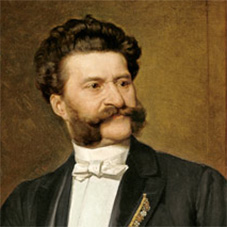
Bio
Austrian composer Johann Strauss surpassed his father, Johann Strauss the Elder's popularity and productivity.Johann Strauss, often referred to as Johann Strauss II, was born on October 25, 1825, in Vienna, Austria. His father, Johann Strauss the Elder, was a self-taught musician who established a musical dynasty in Vienna, writing waltzes, galops, polkas and quadrilles and publishing more than 250 works. Strauss the Elder wanted his son to follow a different career path than he himself had followed, so Strauss II became a bank clerk while secretly studying the violin with a member of his father's company. His father left the family when Strauss was 17, and Strauss soon began openly embracing the musician's life, conducting a band in a Viennese restaurant when he was still a teenager, in 1844. Johann the Younger went on to write more than 500 musical musical compositions, 150 of which were waltzes, and he surpassed both his father's productivity and popularity. Compositions such as The Blue Danube helped establish Strauss as "the Waltz King" and earned him a place in music history. He died in Vienna in June 1899.
Johann Strauss II (1825 – 1899), also known as Johann Strauss Jr., the Younger, the Son Johann Baptist Strauss, son of Johann Strauss I, was an Austrian composer of light music, particularly dance music and operettas. He composed over 500 waltzes, polkas, quadrilles, and other types of dance music, as well as several operettas and a ballet. In his lifetime, he was known as "The Waltz King", and was largely then responsible for the popularity of the waltz in Vienna during the 19th century. Strauss had two younger brothers, Josef and Eduard Strauss, who became composers of light music as well, although they were never as well known as their elder brother. Some of Johann Strauss's most famous works include "The Blue Danube", "Kaiser-Walzer" (Emperor Waltz), "Tales from the Vienna Woods", and the "Tritsch-Tratsch-Polka". Among his operettas, Die Fledermaus and Der Zigeunerbaron are the best known.
 Contact
Contact Basket
Basket My favorites
My favorites My account
My account






